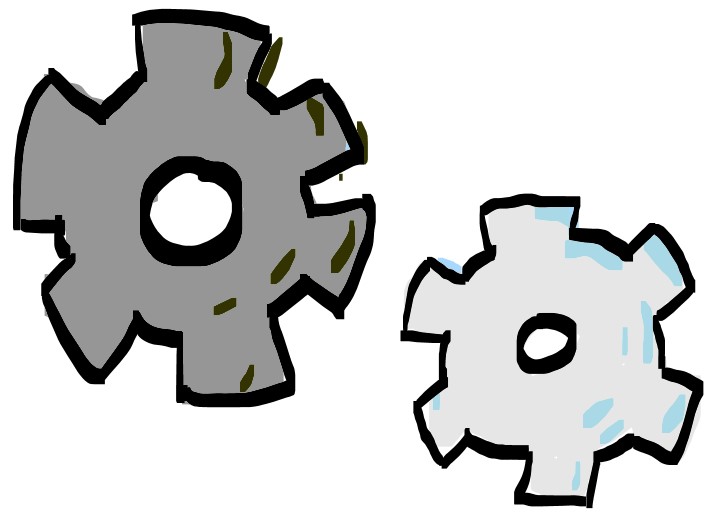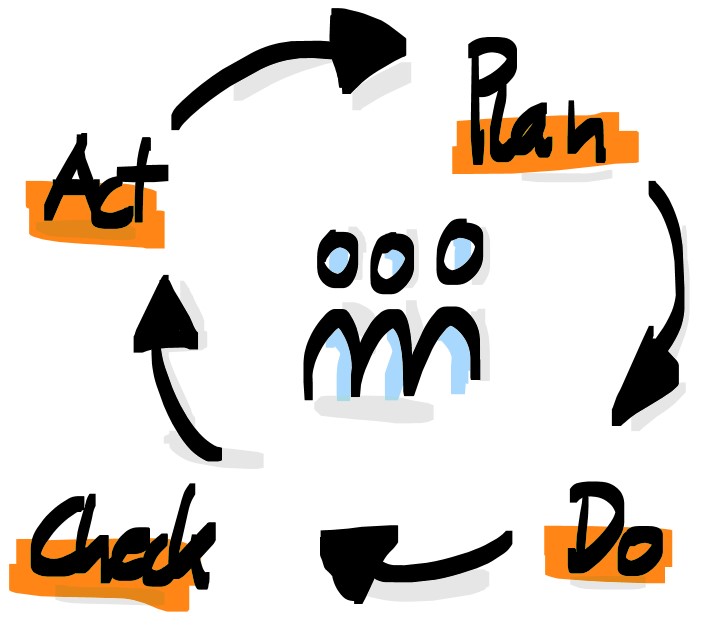The world is no machine. But if it is not, what is it?
Why this question matters? Because our success depends on it.
The other day, a workshop participant asked me why I was bashing the 20th century so much. Apparently, I had explained a bit, well, over-engaged, why the Agile initiatives that are currently being launched everywhere will, in my view, by no means be a short-term phenomenon. Agile forms of collaboration will soon be a natural part of any corporate culture (again). Unlike in the 20th century, that is.

The 20th century…
…has been exceptionally eventful and has produced groundbreaking and unprecedented developments. The production process based on the division of labor is one of them, which allowed work stages to become increasingly efficient and automated. As a result, mass products could be manufactured, sold and delivered ever more quickly, profitably and cheaply. More and larger markets were opened up in this way. This led to a lot of good things:
Growth, prosperity, security. Many, if not most people benefit from it. Is there anything to be said against it?
In the slipstream of these great civilizational achievements, however, it has also led to less good to really catastrophic things. These include quite obvious things such as.
- the ecological crisis (climate crisis, population explosion, massive killing of species, senseless exploitation and waste of resources)
- the political-economic crisis (global “lobbycracy”, the crisis of democracy and autocracy),
- the socio-social crisis (inequality, unequal distribution, maximum economization of life worlds, erosion of the community-oriented solidary life principle, stress and loss of empathy).
- Not least, of course, the many total ideological wars of mass destruction and genocides with their countless inconceivable number of needless victims./1/
In addition – and this is my point here – the untold number of home-grown organizational-structural, cultural and psychological crises is just becoming a MASSIVE problem
Many of these problems take their beginning in the 19th century and are aggravated in the following hundred years. They may be more subtle and less obvious. Nevertheless, they have a similarly unfortunate effect. And also similarly radical.

The Efficiency Logic…
…is based on the idea and experience that the world functions according to cause-effect principles that we can basically recognise and also control (“input ‘X’ produces output ‘Y'”)./2/ This “machine-like” idea of the world leads – and this especially in the 20th century – to people specialising more and more and organising themselves according to the cause-effect principle.
Thus, we humans plan, command and control implementation, mostly in a very hierarchical and serial way. The legitimate hope: if all experts, e.g. management, human resources, heads of department and finally the workers and specialists, only plan well enough, do their work and then monitor implementation and success, it can only work out, failure impossible.
The problems start when we do not recognise (and/or do not want to recognise) that the areas in which we always have been involved, just now increasingly so, are not so clearly structured in their cause-effect relationships. 
This is problematic because machine-like world views lead to rigid and radical patterns of thinking and organisation.
After all, success only comes about if everything is just so, everything and everyone participates and functions as foreseen, planned and agreed upon. From this point of view, patterns of action that arise from such a machine-like view can only result in aggressive, at least one-sided, often even extreme perspectives, positions, approaches, communications and forms of interaction:
Whatever the cost…
… it must be ensured that all those involved in the process do exactly what is to be done at the specified time and also in the manner in which and what is to be done. At the same time, everything that disturbs the coordinated, smooth course towards the goal must be kept away from the system – and out of it. In this way – and only in this way – can we achieve what we want to achieve./3/
This explains why we find ourselves in a world full of very clear hierarchical, ultra-strict and silo-driven structures. This also explains the widespread shirt-sleeved, rough and rather coercive way of dealing in it, which often shows itself in the aggressive (not infrequently also auto-aggressive) behaviour of e.g. investors, owners, management, employees and customers, citizens, politicians or even teachers, pupils and parents. Psycho-logically logical and with force, everything is subordinated to the goal of efficiency. Personal needs, considerations and values are put aside.
This is a bit of an exaggeration. Nevertheless, it does not change the fact that such an attitude is mainstream today, completely normal and unchallenged.

But it has been noticeable for some time now…
…that as a result, many companies are suffering economically. And even more, people are suffering personally and health-wise./4/ Something is changing. More and more people seem to notice that the rigid, obsessive, performance-oriented tunnel vision of efficiency that used to be so successful is now hindering us increasingly in doing good and getting good results. Worse, it is even preventing us from collectively recognising what many individuals of us already feel:
Smoothly mass-distributing products is no longer enough on its own. Besides output, which was so important in the 20th century, something else is becoming important: Taking care of the outcome.
Unfortunately, we are generally not equipped to do this, either organisationally or mentally. We simply don’t know how to do it. Because we haven’t been taught how to do it. In our thinking, in our actions, in our choice of focus, in our structures, we are tuned to something else, and that is efficiency./5/
 Organising Collaboration in an Agile Way…
Organising Collaboration in an Agile Way…
… should always change EXACTLY THAT and alleviate this pain. The organisational misguided developments into excessive, pointless process and stability, into unsustainable efficient performance, should be corrected. Agility focuses for good reason on joint doing and learning, structural flexibility and the question of sustainable value creation.
Yet Agility is increasingly marketed and used today as a tool to make efficient performance organisations even more efficient and powerful (always a pretty sure sign of hype).
Despite this intentional or unintentional misunderstanding – or precisely because of it – there is a lot to be said for me that Agile has come to stay longer. Because for Agile (and certainly for me), the world is not a machine that can be understood and planned down to the smallest detail. The world and its phenomena are rather complex organism with a life of their own. And we should treat it as such
For instance, by adapting to it organisationally. If only for being successful, we should do so.
This text first appeared on www.teamworkblog.de on 9 March 2020.
Notes
/1/ The pre-20th century world, not exactly war-shy either, could not have imagined these proportions in its very worst nightmares.
/2/ This way of thinking has been widespread at least since the Enlightenment when the modern sciences systematically began to explore and map the world in its interconnections. Today, hardly anyone would deny that there are cause-effect relationships that can be recognised in closed, manageable areas and managed and organised accordingly.
/3/ If we succeed in this compulsive piece of art, we speak kindly and mildly of “stable processes”.
/4/ See any health insurance health report of recent years. See the hysterical Design Thinking wave. See the desperate attempts by companies to set up fun New Work workspaces. See the ” Agility training wave”. Etc.
/5/ We have to do things right. What the right things to do are decided by others, teachers, parents, managers, customers for example.
 Organising Collaboration in an Agile Way…
Organising Collaboration in an Agile Way…